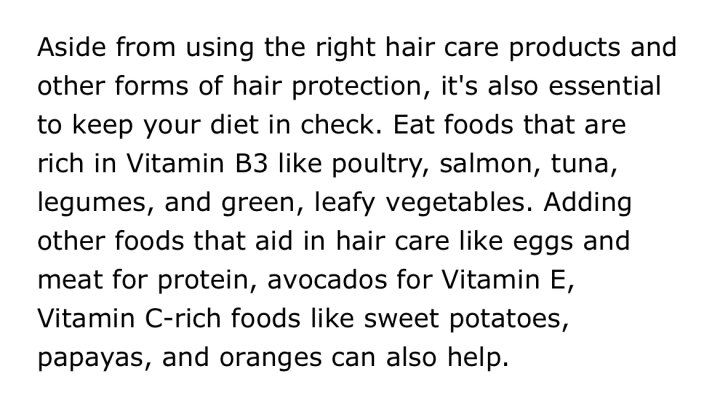PhoenixPhail · M
There are lots of natural cures.
Based on the search results, here are some effective natural remedies for dandruff:
Tea Tree Oil: Mix a few drops of tea tree oil with a carrier oil like coconut or olive oil and massage it into the scalp. Tea tree oil’s antimicrobial properties can help prevent fungal and bacterial growth, reducing dandruff symptoms.
Baking Soda: Use baking soda as a natural exfoliant to remove excess sebum and skin cells. Mix 1 tablespoon of baking soda with your regular shampoo and apply it to the scalp. Leave it on for 1-2 minutes before rinsing. However, use it in moderation as it can be abrasive and strip the scalp of its natural oils.
Apple Cider Vinegar: The acidity in apple cider vinegar can help re-balance the scalp’s pH and soothe irritation. Mix equal parts apple cider vinegar and water as a final rinse after shampooing.
Lemongrass: Lemongrass oil has anti-fungal and antibacterial properties that can help combat dandruff-causing microorganisms. Mix a few drops of lemongrass oil with a carrier oil and apply it to the scalp.
Coconut Oil: Coconut oil’s anti-fungal and moisturizing properties can help soothe and calm the scalp. Apply coconut oil directly to the scalp and massage it in before shampooing.
Aloe Vera: Aloe Vera’s anti-inflammatory and soothing properties can help calm irritated scalps and reduce dandruff symptoms. Apply Aloe Vera gel directly to the scalp and massage it in.
Additional Tips:
Use gentle, fragrance-free shampoos and conditioners.
Avoid harsh chemicals and sulfates, which can exacerbate dandruff.
Reduce stress, as it can contribute to dandruff.
Maintain good scalp hygiene by washing your hair regularly and avoiding sharing personal care items.
Remember to always do a patch test before trying any new remedies, especially if you have sensitive skin. If your dandruff persists or worsens, consult a dermatologist for further guidance.
Good Luck. 😊
Based on the search results, here are some effective natural remedies for dandruff:
Tea Tree Oil: Mix a few drops of tea tree oil with a carrier oil like coconut or olive oil and massage it into the scalp. Tea tree oil’s antimicrobial properties can help prevent fungal and bacterial growth, reducing dandruff symptoms.
Baking Soda: Use baking soda as a natural exfoliant to remove excess sebum and skin cells. Mix 1 tablespoon of baking soda with your regular shampoo and apply it to the scalp. Leave it on for 1-2 minutes before rinsing. However, use it in moderation as it can be abrasive and strip the scalp of its natural oils.
Apple Cider Vinegar: The acidity in apple cider vinegar can help re-balance the scalp’s pH and soothe irritation. Mix equal parts apple cider vinegar and water as a final rinse after shampooing.
Lemongrass: Lemongrass oil has anti-fungal and antibacterial properties that can help combat dandruff-causing microorganisms. Mix a few drops of lemongrass oil with a carrier oil and apply it to the scalp.
Coconut Oil: Coconut oil’s anti-fungal and moisturizing properties can help soothe and calm the scalp. Apply coconut oil directly to the scalp and massage it in before shampooing.
Aloe Vera: Aloe Vera’s anti-inflammatory and soothing properties can help calm irritated scalps and reduce dandruff symptoms. Apply Aloe Vera gel directly to the scalp and massage it in.
Additional Tips:
Use gentle, fragrance-free shampoos and conditioners.
Avoid harsh chemicals and sulfates, which can exacerbate dandruff.
Reduce stress, as it can contribute to dandruff.
Maintain good scalp hygiene by washing your hair regularly and avoiding sharing personal care items.
Remember to always do a patch test before trying any new remedies, especially if you have sensitive skin. If your dandruff persists or worsens, consult a dermatologist for further guidance.
Good Luck. 😊
Frostcloud · F
its probably bc of the humidity. i dont think theres a cure for dandruff beyond certain shampoos/exfoliating
littlepuppywantanewlife · 31-35, M
@Frostcloud There are several options.
shakemeup · 36-40
It's probably the humidity. I had a friend who used baking soda, apple cider vinegar and coconut oil once a week on her scalp.and hair and then rinse it out well.
WandererTony · 56-60, M
Max hairfall also happens during monsoon.
Its the climate. The humidity.
Nothing to worry.
Its the climate. The humidity.
Nothing to worry.

SW-User
I have no idea I always use head and shoulders when
I get rid ofdandruff.
I would assume by keeping your head always clean and gently exfoliating your scalp during shower.
I get rid ofdandruff.
I would assume by keeping your head always clean and gently exfoliating your scalp during shower.
OriginalDumbMan · 36-40
@SW-User the worst shampoo.
Get a horse brush and scrub your scalp. If your hair is too dry after, add oils back to the hair.
I'm not joking about the horse brush. It's designed for pretty much this.
I'm not joking about the horse brush. It's designed for pretty much this.
FreestyleArt · 36-40, M
Use conditioner or whatever kind helps you.
John1994 · 31-35, M
Why you wanna do it naturally? You can simply use a shampoo
matthewjames · 18-21, M
whats monsoon?
DeWayfarer · 61-69, M
@matthewjames
https://ownyourweather.com/difference-between-hurricane-cyclone-typhoon/
https://ownyourweather.com/difference-between-hurricane-cyclone-typhoon/
Hurricanes, cyclones, and typhoons are all predominantly the same type of weather phenomenon, collectively falling under the umbrella term "tropical cyclone." The only significant difference is the part of the world where they occur, as well as the strength of the storm system.
On more than one occasion, you probably got confused and frustrated while watching the news or weather report and observe the seemingly "same occurrence" being called various different names at different times.
The Actual Difference Between A Hurricane, Typhoon, And Cyclone
As already briefly mentioned in the introduction, a hurricane, typhoon, and cyclone are all exactly the same type of weather occurrence.
They all start in the warm water of the Tropics, where vast amounts of humidity provide the fuel for what will eventually become one of these devastating storm systems. They form in the same way and also have exactly the same characteristics.
...
Monsoons
First of all, a monsoon is not a random event that occurs sporadically at different locations. It is a seasonal event that only occurs during the rainy season in specific regions on the planet (predominantly the region stretching from India to Southeast Asia).
Secondly, the way in which a monsoon is formed, as well as its characteristics, differs entirely from the typical hurricane formation and its familiar "rotating & spiraling" shape.
A monsoon is the weather pattern that forms over Southeast Asia, specifically India, during the warm summer months. It is caused by southerly winds moving in from the high-pressure system Please note that a similar weather system occurs over the Southwestern United States (as well as West Africa) during late summer in the region, which is technically also a monsoon. These systems are much weaker and smaller than the ones occurring in Southeast Asia. over the warm Indian and Western Pacific Oceans.
These winds pick up a substantial amount of moisture from the warm ocean water as it moves north towards the low-pressure system present over the continent, bringing with it large torrential rains.
(Just in case you came across the term or may have been wondering, there is such a thing as a winter monsoon. This type of monsoon is characterized by the air flowing in the opposite direction as the airflow during warm summer months.
It is also associated with the resulting dry weather condition that prevails over land during the winter. As a result, whenever a general reference to a monsoon is made, it normally refers to the familiar large-scale system occurring during the summer over Southeast Asia.)
Although they are all technically monsoons, the general reference to "monsoons" and "monsoon season" in global terms are generally associated with the vast weather system in India and Southeast Asia.
On more than one occasion, you probably got confused and frustrated while watching the news or weather report and observe the seemingly "same occurrence" being called various different names at different times.
The Actual Difference Between A Hurricane, Typhoon, And Cyclone
As already briefly mentioned in the introduction, a hurricane, typhoon, and cyclone are all exactly the same type of weather occurrence.
They all start in the warm water of the Tropics, where vast amounts of humidity provide the fuel for what will eventually become one of these devastating storm systems. They form in the same way and also have exactly the same characteristics.
...
Monsoons
First of all, a monsoon is not a random event that occurs sporadically at different locations. It is a seasonal event that only occurs during the rainy season in specific regions on the planet (predominantly the region stretching from India to Southeast Asia).
Secondly, the way in which a monsoon is formed, as well as its characteristics, differs entirely from the typical hurricane formation and its familiar "rotating & spiraling" shape.
A monsoon is the weather pattern that forms over Southeast Asia, specifically India, during the warm summer months. It is caused by southerly winds moving in from the high-pressure system Please note that a similar weather system occurs over the Southwestern United States (as well as West Africa) during late summer in the region, which is technically also a monsoon. These systems are much weaker and smaller than the ones occurring in Southeast Asia. over the warm Indian and Western Pacific Oceans.
These winds pick up a substantial amount of moisture from the warm ocean water as it moves north towards the low-pressure system present over the continent, bringing with it large torrential rains.
(Just in case you came across the term or may have been wondering, there is such a thing as a winter monsoon. This type of monsoon is characterized by the air flowing in the opposite direction as the airflow during warm summer months.
It is also associated with the resulting dry weather condition that prevails over land during the winter. As a result, whenever a general reference to a monsoon is made, it normally refers to the familiar large-scale system occurring during the summer over Southeast Asia.)
Although they are all technically monsoons, the general reference to "monsoons" and "monsoon season" in global terms are generally associated with the vast weather system in India and Southeast Asia.
Ketomac
Longpatrol · 31-35, M
Is your head often getting wet and dry???
It could be this irritating your skin and the dandruff is your body's way of complaining about it.
It could be this irritating your skin and the dandruff is your body's way of complaining about it.
OriginalDumbMan · 36-40
Shave head
Awesomenih · 41-45, M
Use head and shoulders
BigGuy2 · 31-35, M
Go online an order the shampoo:
Head & Shoulders
Head & Shoulders
OriginalDumbMan · 36-40
@BigGuy2 the worst shampoo
BigGuy2 · 31-35, M
@OriginalDumbMan it works for me
This comment is hidden.
Show Comment





















